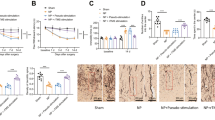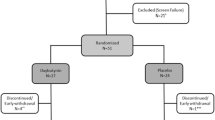Abstract
Previous studies showed that repeated intrathecal morphine injection activated the mammalian target of rapamycin complex 1 (mTORC1) in spinal dorsal horn neurons and that blocking this activation by intrathecal infusion of rapamycin, a specific mTORC1 inhibitor, prevented the initiation of morphine-induced tolerance and hyperalgesia. However, in clinic, rapamycin is usually administrated orally. In this study, we examined whether systemic administration of rapamycin had the effect on morphine-induced tolerance and hyperalgesia in mice. Repeatedly intraperitoneal injection of morphine led to morphine analgesic tolerance on day 5 post-injection evidenced by a marked decrease in morphine’s maximal possible analgesic effect and hyperalgesia on day 6 post-injection demonstrated by significant increases in paw withdrawal frequency in response to mechanical stimulation and decreases in paw withdrawal latency in response to cold stimulation on bilateral sides. Co-intraperitoneal injection with rapamycin prevented the development of morphine analgesic tolerance and hyperalgesia. Moreover, on day 6 after morphine injection, co-intraperitoneal injection with rapamycin reduced the established morphine tolerance and hyperalgesia. Co-intraperitoneal injection of rapamycin also attenuated the morphine-induced increases in the levels of phosphorylated mTOR and its downstream target phosphorylated 4E-BP1 in the spinal cord dorsal horn. Our findings indicate that, like intrathecal injection, systemic administration of rapamycin has significant effects on both induction and maintenance of morphine tolerance and hyperalgesia. Systemic mTOR inhibitors could serve as promising medications for use as adjuvants with opioids in clinical chronic pain management.




Similar content being viewed by others
References
Yu G, Zhang FQ, Tang SE, Lai MJ, Su RB, Gong ZH (2014) Continuous infusion versus intermittent bolus dosing of morphine: a comparison of analgesia, tolerance, and subsequent voluntary morphine intake. J Psychiatr Res 59:161–166
Bekhit MH (2010) Opioid-induced hyperalgesia and tolerance. Am J Ther 17:498–510
Ueda H, Ueda M (2009) Mechanisms underlying morphine analgesic tolerance and dependence. Front Biosci (Landmark Ed) 14:5260–5272
Szabo I, Chen XH, Xin L, Adler MW, Howard OM, Oppenheim JJ, Rogers TJ (2002) Heterologous desensitization of opioid receptors by chemokines inhibits chemotaxis and enhances the perception of pain. Proc Natl Acad Sci USA 99:10276–10281
Mayer DJ, Mao J, Holt J, Price DD (1999) Cellular mechanisms of neuropathic pain, morphine tolerance, and their interactions. Proc Natl Acad Sci USA 96:7731–7736
Xu JT, Zhou X, Zhao X, Ligons D, Tiwari V, Lee CY, Atianjoh FE, Liang L, Zang W, Njoku D, Raja SN, Yaster M, Tao YX (2014) Opioid receptor-triggered spinal mTORC1 activation contributes to morphine tolerance and hyperalgesia. J Clin Invest 124:592–603
Swiech L, Perycz M, Malik A, Jaworski J (2008) Role of mTOR in physiology and pathology of the nervous system. Biochim Biophys Acta 1784:116–132
Gingras AC, Raught B, Sonenberg N (2001) Regulation of translation initiation by FRAP/mTOR. Genes Dev 15:807–826
Xu JT, Sun L, Lutz BM, Bekker A, Tao YX (2015) Intrathecal rapamycin attenuates morphine-induced analgesic tolerance and hyperalgesia in rats with neuropathic pain. Transl Perioper Pain Med 2:27–34
Lutz BM, Nia S, Xiong M, Tao YX, Bekker A (2015) mTOR, a new potential target for chronic pain and opioid-induced tolerance and hyperalgesia. Mol Pain 11:32
Danesi R, Boni JP, Ravaud A (2013) Oral and intravenously administered mTOR inhibitors for metastatic renal cell carcinoma: pharmacokinetic considerations and clinical implications. Cancer Treat Rev 39:784–792
Liang L, Zhao JY, Gu X, Wu S, Mo K, Xiong M, Bekker A, Tao YX (2016) G9a inhibits CREB-triggered expression of mu opioid receptor in primary sensory neurons following peripheral nerve injury. Mol Pain 12:1744806916682242
Zhao JY, Liang L, Gu X, Li Z, Wu S, Sun L, Atianjoh FE, Feng J, Mo K, Jia S, Lutz BM, Bekker A, Nestler EJ, Tao YX (2016) DNA methyltransferase DNMT3a contributes to neuropathic pain by repressing Kcna2 in primary afferent neurons. Nat. Commun 8:14712
Costa-Mattioli M, Sossin WS, Klann E, Sonenberg N (2009) Translational control of long-lasting synaptic plasticity and memory. Neuron 61:10–26
Ossipov MH, Lai J, King T, Vanderah TW, Porreca F (2005) Underlying mechanisms of pronociceptive consequences of prolonged morphine exposure. Biopolymers 80:319–324
Xu JT, Zhao X, Yaster M, Tao YX (2010) Expression and distribution of mTOR, p70S6K, 4E-BP1, and their phosphorylated counterparts in rat dorsal root ganglion and spinal cord dorsal horn. Brain Res 1336:46–57
Liang L, Tao B, Fan L, Yaster M, Zhang Y, Tao YX (2013) mTOR and its downstream pathway are activated in the dorsal root ganglion and spinal cord after peripheral inflammation, but not after nerve injury. Brain Res 1513:17–25
Mazei-Robison MS, Koo JW, Friedman AK, Lansink CS, Robison AJ, Vinish M, Krishnan V, Kim S, Siuta MA, Galli A, Niswender KD, Appasani R, Horvath MC, Neve RL, Worley PF, Snyder SH, Hurd YL, Cheer JF, Han MH, Russo SJ, Nestler EJ (2011) Role for mTOR signaling and neuronal activity in morphine-induced adaptations in ventral tegmental area dopamine neurons. Neuron 72:977–990
Cui Y, Zhang XQ, Cui Y, Xin WJ, Jing J, Liu XG (2010) Activation of phosphatidylinositol 3-kinase/Akt-mammalian target of Rapamycin signaling pathway in the hippocampus is essential for the acquisition of morphine-induced place preference in rats. Neuroscience 171:134–143
United States Food and Drug Administration (2015) Rapamycin prescribing information. Wyeth Pharmaceuticals, Inc., Philadelphia
Acknowledgements
This work was supported by the Key Projects of National Health and Family Planning Commission of Tianjin, China (16KG157).
Author information
Authors and Affiliations
Corresponding author
Ethics declarations
Conflict of interest
The authors declare that there are no conflicts of interest with respect to the research, authorship, and/or publication of this article.
Rights and permissions
About this article
Cite this article
Zhang, J., Wang, Y. & Qi, X. Systemic Rapamycin Attenuates Morphine-Induced Analgesic Tolerance and Hyperalgesia in Mice. Neurochem Res 44, 465–471 (2019). https://doi.org/10.1007/s11064-018-2699-0
Received:
Revised:
Accepted:
Published:
Issue Date:
DOI: https://doi.org/10.1007/s11064-018-2699-0




